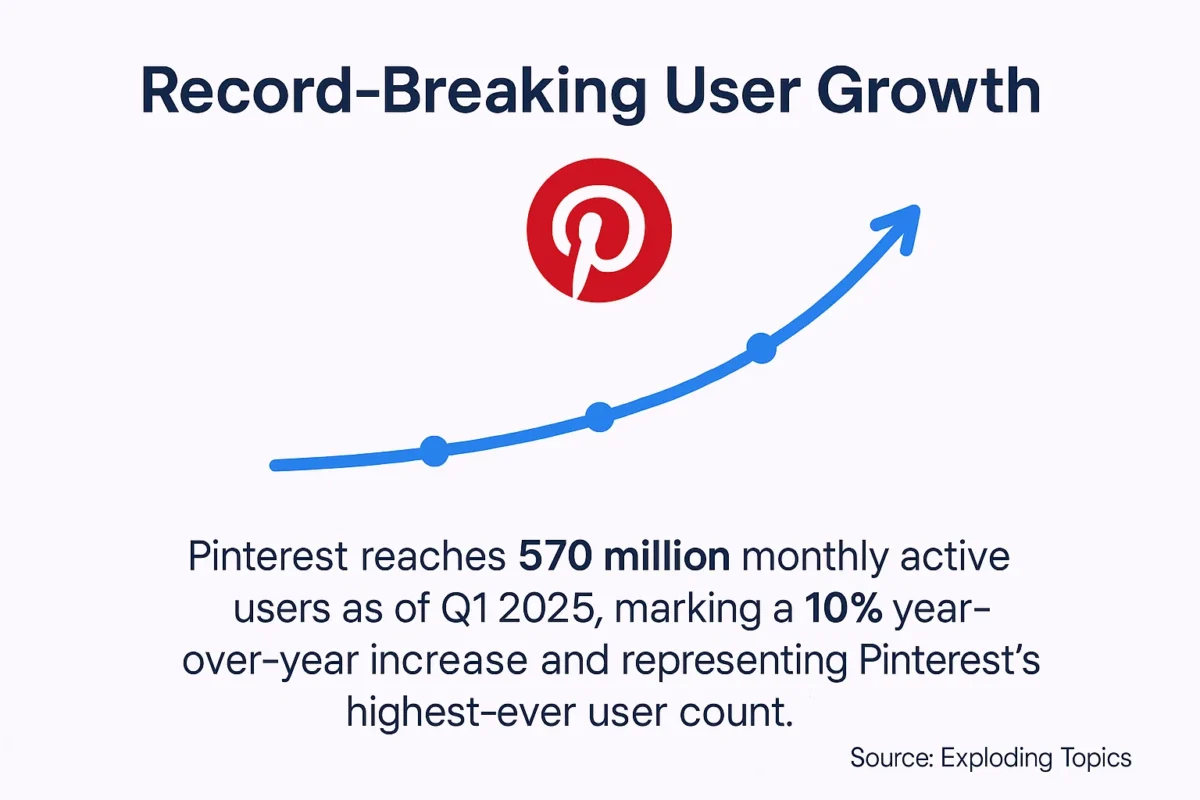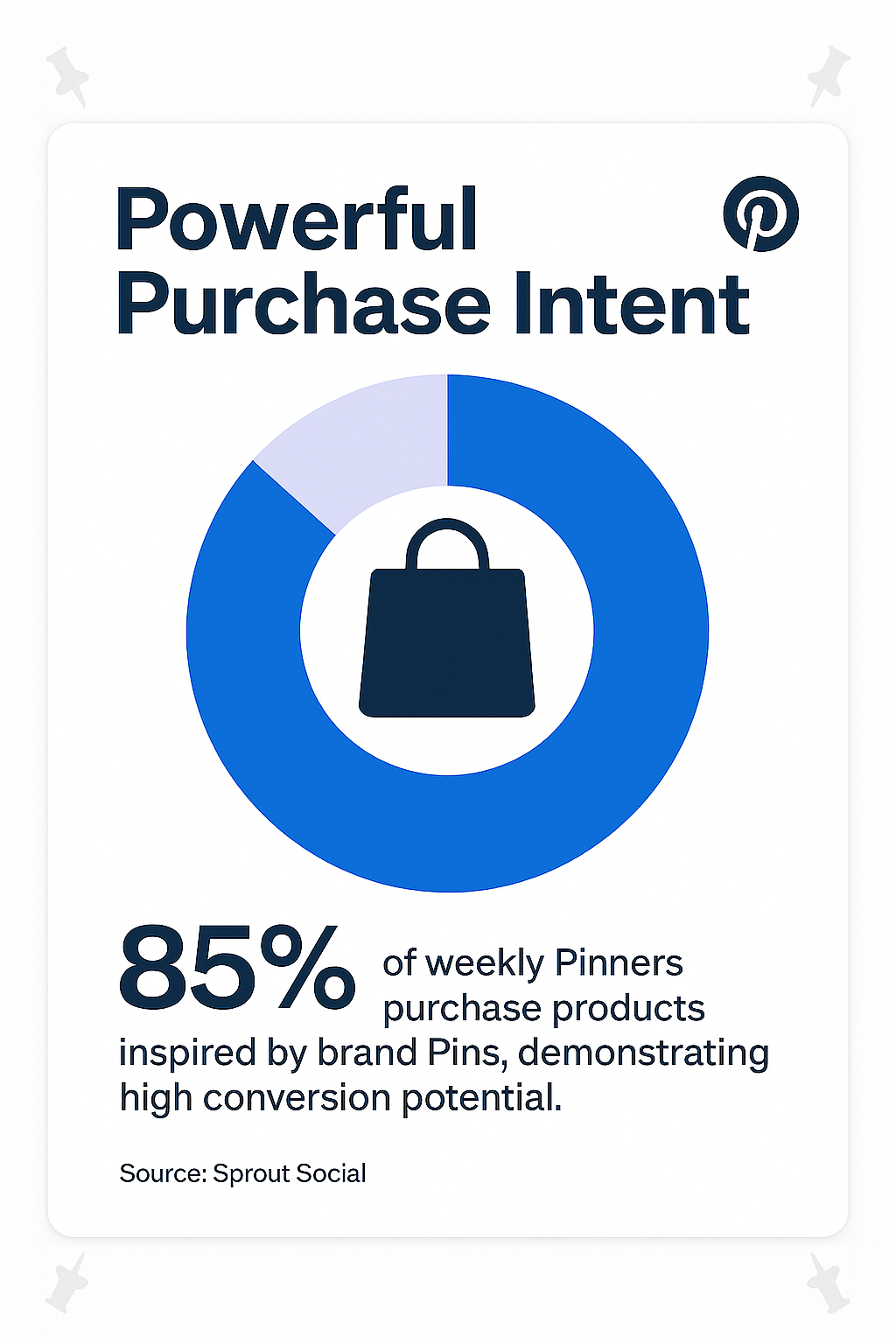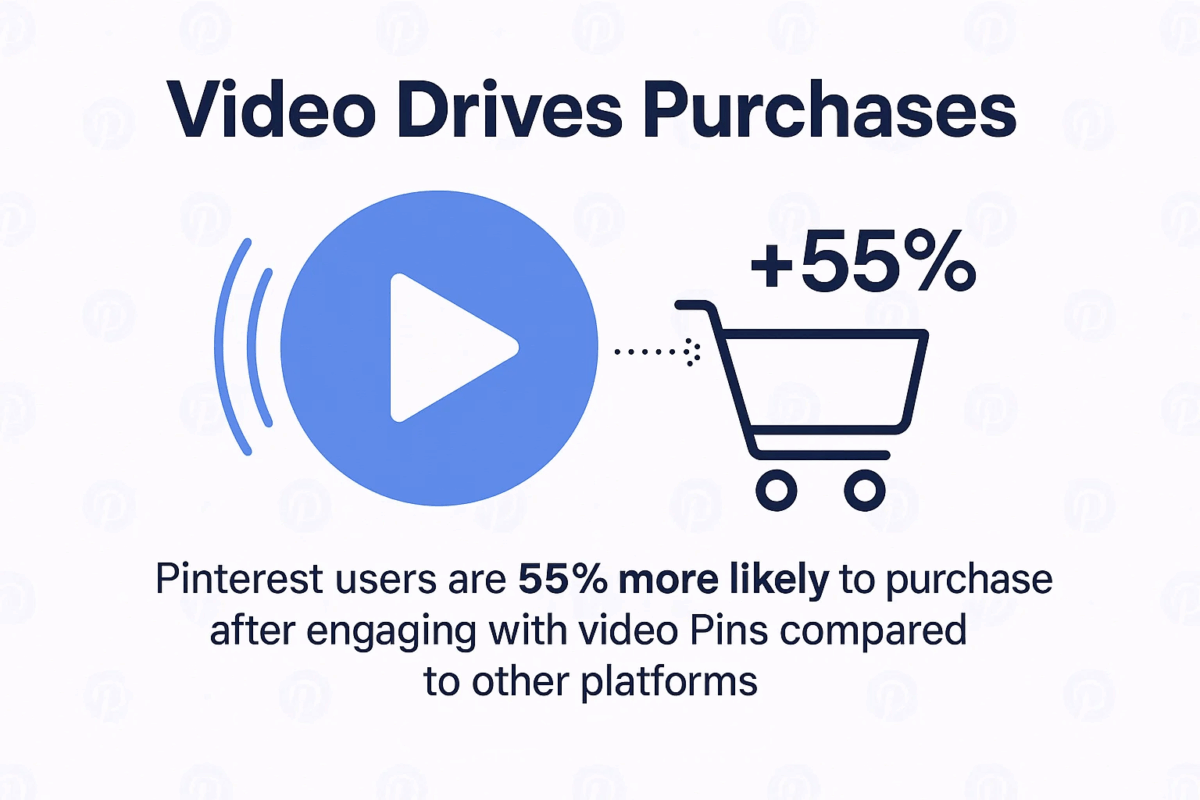Pinterest stands out in the social media landscape. It functions differently from platforms like Instagram or Facebook. Users visit Pinterest specifically to find products and ideas. This behavior makes it ideal for affiliate marketing.
Many affiliate marketers overlook Pinterest’s potential. They focus on Instagram or blogs instead. Meanwhile, Pinterest continues to grow as a product discovery powerhouse. The platform’s visual nature perfectly showcases affiliate products.
Here’s why Pinterest deserves your attention as an affiliate marketer:
- Higher purchase intent from users
- Longer content lifespan than other platforms
- Less saturated with affiliate content
- Strong referral traffic to external sites
- Visual discovery that showcases products effectively
This guide will show you how to leverage Pinterest strategically. You’ll learn to set up your account properly. You’ll discover how to create pins that convert. Most importantly, you’ll understand how to build a sustainable affiliate marketing system on Pinterest.
Why Pinterest Is Uniquely Positioned for Affiliate Marketing
Pinterest offers distinct advantages for affiliate marketers. It combines search engine functionality with social media engagement. Users approach Pinterest with shopping and planning mindsets. This intent-driven behavior translates to higher conversion potential.

The platform continues to grow impressively. Pinterest reaches 570 million monthly active users as of Q1 2025, marking a 10% year-over-year increase and representing Pinterest’s highest-ever user count.
What makes Pinterest especially valuable for affiliate marketing? Let’s examine the key statistics that highlight its potential:
| Pinterest Metric | Why It Matters for Affiliate Marketing |
|---|
| 85% of weekly Pinners purchase products inspired by brand Pins | High purchase intent translates to better affiliate conversion rates |
| 96% of top Pinterest searches are unbranded | Users are open to discovering new products/brands through your affiliate links |
| 1.5 billion Pins saved weekly | Massive content engagement creates ongoing exposure opportunities |
| 3.5+ month average Pin lifespan | Affiliate content continues driving traffic long after posting |
| 33% more referral traffic than Facebook | Higher click-through rates to your affiliate landing pages |
The most compelling advantage is user purchasing behavior. 85% of weekly Pinners purchase products inspired by brand Pins, demonstrating high conversion potential.

Another significant benefit is content longevity. Pinterest content stays relevant much longer than posts on other platforms. While Facebook posts typically disappear from feeds within 5 hours, Pins remain discoverable for 3.5+ months on average, creating sustained exposure for your affiliate offers.
Pinterest also drives impressive external traffic. The platform generates 33% more referral traffic to e-commerce sites than Facebook, making it particularly valuable for affiliate marketers who need users to click through to retailer sites.
Understanding Pinterest’s audience demographics helps target your affiliate efforts effectively. Gen Z constitutes 42% of Pinterest’s global user base, with a 70% female user skew, though male adoption continues rising.
Let’s build on these advantages. I’ll show you how to set up your Pinterest presence for affiliate success.
Setting Up Your Pinterest Account for Affiliate Success
The foundation of successful Pinterest affiliate marketing begins with proper account setup. Many marketers rush this step. Taking time to optimize your profile pays dividends later.
Start by creating a business account. Personal accounts limit your marketing capabilities. Business accounts provide analytics, rich pins, and advertising options. These features prove essential for serious affiliate marketers.
When setting up your profile, focus on these key elements:
| Pinterest Account Element | Optimization Tips for Affiliate Marketing | Example |
|---|
| Username | Include primary keyword, keep professional | OrganicBeautyHub, HomeGadgetsGuide |
| Profile Description | Include 3-5 niche keywords, explain value proposition | “Helping home chefs find the perfect kitchen tools. Discover top-rated appliances, gadgets, and cookware for your culinary adventures.” |
| Profile Image | Clean, high-contrast image that’s recognizable at small sizes | Simple logo or professional headshot with good lighting |
| Cover Image | Showcase niche/products with cohesive branded imagery | Collage of product categories you promote or lifestyle imagery |
| Website Link | Direct to content hub or targeted landing page | Blog homepage or niche-specific product comparison page |
Your profile description requires strategic keyword placement. Include terms your ideal audience searches for. Explain what value you provide through your pins. Keep it concise but informative.
Next, create strategic Pinterest boards that align with your affiliate marketing niches. Boards serve as content categories that help users discover your pins. They also signal to Pinterest what topics you cover.
For affiliate marketing, create these essential board types:
- Product-specific boards: Dedicated to specific product categories you promote
- Problem-solution boards: Organized around problems your affiliate products solve
- Lifestyle/aspiration boards: Showcasing the lifestyle your products enhance
- Educational content boards: Providing value beyond product promotion
- Seasonal/trending boards: Aligning with timely topics relevant to your niche
Each board should have a keyword-rich description. This helps Pinterest understand your content for search visibility. Include 2-3 relevant hashtags per board description as well.
Before actively promoting affiliate products, populate each board with at least 10-15 high-quality pins. This creates a complete, trustworthy presence. Mix your own content with relevant curated pins from reputable sources.
Overwhelmed by Digital Marketing?
Just released: my new book to help small businesses, entrepreneurs, and marketers master digital marketing in today’s digital-first world.
Drawing on my Fractional CMO experience, Digital Threads simplifies complex strategies into clear, actionable steps for success.
Transform your business today—grab your copy! Click the cover or button below to buy on Amazon.
With your account foundation established, let’s explore how to create Pinterest content that drives affiliate sales.
Creating Effective Affiliate Content for Pinterest
Creating pins that convert requires understanding Pinterest’s visual nature. The platform rewards beautiful, useful imagery. Your affiliate content must stand out while providing clear value.
I’ve found that certain pin types perform consistently well for affiliate marketing. Static image pins work for showcasing products. Idea pins (Pinterest’s multi-page format) excel for tutorials and comparisons. Video pins generate higher engagement and purchase intent.

In fact, Pinterest users are 55% more likely to purchase after engaging with video Pins compared to other platforms, making this format particularly valuable for affiliate conversions. This visual engagement translates directly to higher affiliate earnings potential.
Let’s compare the different pin formats for affiliate marketing effectiveness:
| Pin Format | Best Used For | Affiliate Effectiveness | Creation Complexity |
|---|
| Static Image Pin | Product showcases, comparison charts, before/after results | Good | Low |
| Video Pin | Product demonstrations, unboxings, how-to guides | Excellent | Medium |
| Idea Pin (Multi-page) | Step-by-step tutorials, product comparisons, collections | Very Good | Medium |
| Shop-enabled Pin | Direct product promotion with pricing | Very Good | Low (requires merchant account) |
| Carousel Pin | Multiple product views, feature breakdowns | Good | Medium |
When designing pins for affiliate marketing, follow these design principles:
First, use vertical images with 2:3 aspect ratio (1000 × 1500 pixels ideal). Include clear, readable text overlay that communicates value. Use high-quality product images with clean backgrounds. Incorporate your branded colors and fonts consistently. Create a clear visual hierarchy that guides the eye.
The text overlay on your pin should answer “What’s in it for me?” from the user’s perspective. Phrases like “10 Best Air Fryers for Small Kitchens” or “5 Skincare Products That Fixed My Acne” perform well.
You can create professional-looking pins without design skills using free and low-cost tools specifically designed for Pinterest graphics. These tools offer templates optimized for Pinterest’s preferred dimensions and styles.
Pin descriptions play a crucial role in your affiliate strategy. They should include your primary keywords in the first 50-60 characters. Tell a compelling story about the product’s benefits. Address a specific problem the product solves. Include a clear call-to-action. Disclose affiliate relationships transparently.
Here’s an example of an effective affiliate pin description:
“These waterproof Bluetooth earbuds transformed my workouts! ?? No more sweat damage or falling out during runs. They offer 8+ hours of battery life and crystal-clear sound quality. Click to see why they’re my top recommendation for fitness enthusiasts! #fitnessgear #workoutessentials (affiliate link)”
Notice the transparent disclosure and clear value proposition. This honesty builds trust with your audience. It also complies with FTC guidelines for affiliate marketing.
Pinterest SEO Fundamentals for Affiliate Marketers
Pinterest functions as a visual search engine. Understanding its SEO principles helps your affiliate content reach more potential buyers. Visibility begins with strategic keyword usage.
Unlike Google, Pinterest SEO relies heavily on exact-match keywords. The platform’s search algorithm looks for specific terms in your profile, board names, pin titles, and descriptions. Finding the right keywords directly impacts your success.
To identify effective Pinterest keywords, start with these approaches:
Use Pinterest’s search bar suggestions. Study related terms that appear below search results. Analyze what terms top performers in your niche use. Look at shopping-intent modifiers like “best,” “affordable,” or “top-rated.”
When you enter a seed keyword into Pinterest’s search bar, it suggests popular related searches. These suggestions reveal exactly what Pinterest users are looking for. They provide valuable insights for your affiliate content strategy.
Now, let’s look at how to implement these keywords throughout your Pinterest presence:
| Pinterest Element | Keyword Placement Strategy | Example |
|---|
| Pin Title | Primary keyword first, secondary keywords later | “Affordable Camping Gear: 7 Budget-Friendly Essentials for Beginners” |
| Pin Description | Primary keyword in first 50-60 characters, natural inclusion of secondary terms | “Affordable camping gear that won’t break the bank! These budget-friendly essentials make outdoor adventures possible without spending a fortune. Perfect for beginners and casual campers looking to start exploring nature.” |
| Board Names | Clear, keyword-focused categories | “Budget Camping Gear” instead of “Outdoor Stuff” |
| Board Descriptions | Expanded keyword variations with natural phrasing | “Affordable camping equipment for beginners and budget-conscious adventurers. Find the best inexpensive tents, sleeping bags, and camping accessories for your outdoor journey.” |
| Image Alt Text | Descriptive text with primary keyword | “Affordable 2-person tent with rainfly for budget camping beginners” |
Beyond keywords, Pinterest’s algorithm considers engagement metrics. Pins that receive saves, clicks, and comments rank higher in search results. Create content that encourages these interactions.
What strategies work best for increasing Pinterest engagement and visibility? My experience shows that asking questions in your pin text or descriptions encourages comments. Creating “pin-worthy” content that solves specific problems drives saves.
Fresh content also receives preferential treatment in Pinterest’s algorithm. Regularly create new pins for the same affiliate products or content. Update imagery, text angles, and descriptions to keep your presence current.
Strategic Pinning Techniques to Drive Affiliate Sales
Consistent, strategic pinning delivers better results than random posting. Pinterest rewards accounts that maintain regular activity. This consistency signals quality to the algorithm.
How often should you pin for affiliate marketing success? Most successful Pinterest affiliate marketers pin 5-10 times daily. This frequency maintains visibility without overwhelming followers. Quality always outweighs quantity.
The timing of your pins impacts their performance. Pin when your target audience is most active on the platform. For most niches, these time periods perform well:
| Time Period | Best For | User Behavior |
|---|
| 7-9 AM | Productivity, business, education content | Morning planning and information gathering |
| 12-2 PM | Quick ideas, food, fashion | Lunch break browsing |
| 8-11 PM | Home decor, DIY, leisure products | Evening relaxation and aspiration browsing |
| Weekends | Project-based products, major purchases | Extended browsing and project planning |
| Seasonal periods | Holiday-specific products | Focused shopping for upcoming events |
To determine your ideal pinning schedule, examine your Pinterest analytics. Look for patterns in when your audience engages most with your content. Adjust your schedule accordingly.
Group boards remain valuable for extending your reach. These shared boards allow multiple contributors to pin content to the same collection. Joining relevant group boards puts your affiliate pins in front of established audiences.
When seeking group boards, look for those that have high engagement (saves and comments). Maintain reasonable contributor-to-follower ratios. Allow affiliate content (check board rules). Align closely with your niche. Show recent activity (not abandoned).
The 80/20 rule applies to Pinterest affiliate marketing. Spend 80% of your effort creating and pinning valuable, helpful content. Limit direct affiliate promotion to 20% of your pins. This balanced approach builds trust and prevents audience fatigue.
Learning effective selling techniques on Pinterest enhances your affiliate marketing success. The platform favors soft-selling approaches that prioritize inspiration and problem-solving over aggressive promotion.
Another powerful strategy involves creating multiple pins for the same affiliate product or content. Design 3-5 different pin images highlighting various benefits, features, or use cases. This approach tests what resonates best with your audience while increasing visibility.
Tracking performance metrics reveals what’s working in your Pinterest affiliate strategy. Without measurement, you’re operating on guesswork. Pinterest Business accounts provide robust analytics to guide your decisions.
The key metrics to monitor fall into these categories:
- Visibility metrics: Impressions, reach, and search appearances
- Engagement metrics: Saves, clicks, comments, and close-ups
- Traffic metrics: Website visits, outbound clicks, and clickthrough rate
- Audience metrics: Follower growth and demographic information
- Conversion metrics: Affiliate link clicks and conversion rates
Pinterest’s native analytics dashboard shows most of these metrics. For tracking specific affiliate performance, use your affiliate network’s reporting tools or UTM parameters in your links.
Let’s examine which metrics matter most for affiliate marketing success:
| Metric | Why It Matters | Optimization Action |
|---|
| Outbound Click Rate | Directly impacts affiliate link clicks and commission potential | Improve pin call-to-actions and value propositions |
| Save Rate | Indicates content quality and extends pin lifespan | Create more “save-worthy” content that solves specific problems |
| Conversion Rate | Shows how well your audience converts after clicking | Test different affiliate products or improve landing page alignment |
| Engagement by Topic | Reveals which product categories perform best | Focus more content on high-performing topics |
| Top Performing Pins | Identifies your most successful content patterns | Analyze and replicate elements of top performers |
A/B testing accelerates your Pinterest affiliate optimization. Create variations of your pins with single changed elements. Test different pin designs and layouts. Try various text overlays and copywriting angles. Experiment with call-to-action phrases. Compare image styles (lifestyle vs. product-focused). Test color schemes and branding approaches.
When analyzing test results, look beyond simple engagement metrics. Focus on the entire conversion funnel from impression to affiliate sale. Sometimes pins with lower save rates generate higher actual commissions.
For tracking affiliate links from Pinterest, use unique tracking links for each pin or campaign. Most affiliate networks allow custom tracking ID creation. This granular tracking reveals exactly which pins drive revenue.
Successful Pinterest affiliate marketers allocate time for regular performance reviews. Schedule monthly analysis sessions to identify trends, top performers, and improvement opportunities. Use these insights to refine your strategy.
The most valuable optimization approach is “more of what works.” When you identify high-performing affiliate content, create additional variations on that theme. Expand on successful topics with different angles, products, or visual approaches.
Pinterest Affiliate Marketing Rules and Best Practices
Compliance with platform rules and legal requirements protects your Pinterest affiliate business. The platform has specific policies regarding affiliate marketing. Understanding these rules prevents account restrictions or termination.
Pinterest’s affiliate marketing guidelines include disclosure requirements for all affiliate content. They also cover prohibited affiliate product categories. Landing page quality requirements matter too. The platform restricts identical or repetitive content. Certain promotional language faces limitations.
The most important requirement is proper disclosure. Pinterest requires clear indication of affiliate relationships. Include phrases like “(affiliate link)” or “#ad” in your pin descriptions. This transparency builds trust and satisfies FTC requirements.
Certain product categories face additional restrictions or prohibitions. Pinterest limits or bans affiliate promotion of:
| Product Category | Pinterest Restriction Level | Workaround Options |
|---|
| Adult products and services | Prohibited | None – avoid completely |
| Weight loss products | Heavily restricted | Focus on healthy lifestyle, not “before/after” or miracle claims |
| Financial services | Restricted | Educational content with careful affiliate disclosure |
| Health supplements | Restricted | Informational content without medical claims |
| Multi-level marketing | Restricted | Product benefits only, not business opportunity |
Beyond platform rules, successful Pinterest affiliate marketers follow these best practices:
Promote products you genuinely recommend. Create valuable content beyond basic product promotion. Build topic authority before heavy affiliate promotion. Maintain consistent visual branding across pins. Respond to comments and engage with your audience.
The biggest mistake new Pinterest affiliate marketers make is overpromotion. Constantly pushing affiliate links without providing value damages your account’s performance. Pinterest’s algorithm favors accounts that contribute quality content to the platform ecosystem.
Another common pitfall is poor landing page experience. When users click your affiliate links, the destination page should align with the pin’s promise. Misleading pins lead to high bounce rates, lower trust, and reduced algorithm favor.
To avoid these issues, regularly audit your affiliate content. Remove underperforming pins that might damage your account’s standing. Update older affiliate content with current information and refreshed designs. This maintenance preserves your account’s quality score.
Understanding the differences between influencer marketing and affiliate marketing helps create more effective Pinterest strategies. While related, these approaches require different content styles and relationship management.
Build credibility by mixing informational and affiliate content. Create valuable resources that help users solve problems related to your niche. This approach establishes you as a trusted advisor rather than just a promoter.

Conclusion
Pinterest offers exceptional opportunities for affiliate marketers. Its visual discovery nature, shopping-intent user base, and long content lifespan create ideal conditions for affiliate success. The platform continues growing while maintaining strong purchase behaviors.
We’ve covered the essential elements of Pinterest affiliate marketing. We explored why Pinterest’s unique attributes benefit affiliate marketers. We discussed setting up a Pinterest business account optimized for affiliate promotion. We examined creating pin designs that drive engagement and clicks. We looked at implementing Pinterest SEO principles for greater visibility. We covered strategic pinning techniques that maximize reach. We discussed measuring and optimizing your affiliate performance. Finally, we reviewed following platform rules and best practices for sustainable success.
Getting started with Pinterest affiliate marketing requires commitment. The platform rewards consistency and quality over time. Your initial efforts build the foundation for long-term passive affiliate income.
Take these immediate actions to begin your Pinterest affiliate marketing journey:
- Create or convert to a Pinterest business account
- Set up 5-10 strategic boards aligned with your affiliate niches
- Design your first 10-15 affiliate pins using the principles covered
- Implement a consistent pinning schedule (5-10 pins daily)
- Track performance metrics and optimize based on data
Remember that Pinterest success doesn’t happen overnight. The compounding nature of the platform means your efforts build upon themselves. What seems like slow progress initially often accelerates as your pins gain traction and authority.
I encourage you to explore specialized Pinterest tools that can accelerate your affiliate marketing results. These resources automate routine tasks and enhance your strategic capabilities.
Have you already tried affiliate marketing on other platforms? Pinterest might provide the perfect complement to your existing strategies. Its unique advantage of extended content lifespan means your effort continues generating returns far longer than on other social platforms.
Start implementing these Pinterest affiliate marketing strategies today. The platform’s growth trajectory and commerce focus make it an increasingly valuable channel for affiliate revenue. The marketers who establish themselves now will benefit most from Pinterest’s continued evolution as a shopping destination.
Actionable advice for your digital / content / influencer / social media marketing.
Join 13,000+ smart professionals who subscribe to my regular updates.